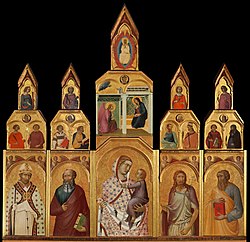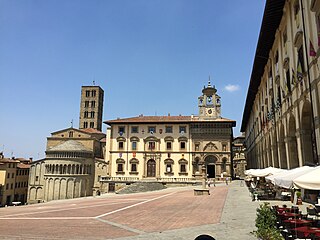
Arezzo is a city and comune in Italy and the capital of the province of the same name located in Tuscany. Arezzo is about 80 kilometres southeast of Florence at an elevation of 296 metres (971 ft) above sea level. As of 2022, the population was about 97,000.
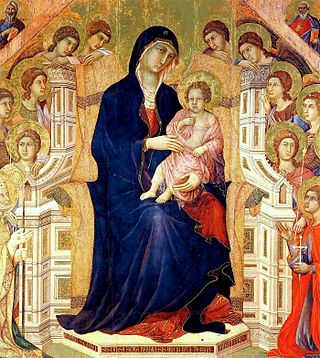
Duccio di Buoninsegna, commonly known as just Duccio, was an Italian painter active in Siena, Tuscany, in the late 13th and early 14th century. He was hired throughout his life to complete many important works in government and religious buildings around Italy. Duccio is considered one of the greatest Italian painters of the Middle Ages, and is credited with creating the painting styles of Trecento and the Sienese school. He also contributed significantly to the Sienese Gothic style.

Ambrogio Lorenzetti was an Italian painter of the Sienese school. He was active from approximately 1317 to 1348. He painted The Allegory of Good and Bad Government in the Sala dei Nove in Siena's Palazzo Pubblico. His elder brother was the painter Pietro Lorenzetti.

Pietro Lorenzetti or Pietro Laurati was an Italian painter, active between c. 1306 and 1345. Together with his younger brother Ambrogio, he introduced naturalism into Sienese art. In their artistry and experiments with three-dimensional and spatial arrangements, the brothers foreshadowed the art of the Renaissance.

Castiglion Fiorentino is a small, walled city in eastern Tuscany, Italy, in the province of Arezzo, between the cities of Arezzo and Cortona. It is known for its annual festivals and its Etruscan archeological site.

Jacopo del Casentino was an Italian painter, active mainly in Tuscany in the first half of the 14th century.

Guido Tarlati was a lord and Bishop of Arezzo.
Andrea Vanni was an Italian painter of the early Renaissance, active mainly in his native Siena.
The decade of the 1330s in art involved some significant events.
The decade of the 1320s in art involved some significant events.

Pier Saccone Tarlati di Pietramala (1261–1356) was an Italian condottiero from Pietramala d'Arezzo in the Val d'Arno, a rocca that controlled the mule track between his native town of Arezzo and Anghiari. Pietramala was the seat of the powerful family of the Tarlati, who came to prominence in the strife following Arezzo's decisive defeat at Campaldino (1289) as heads of the Ghibelline "Secchi" faction of Arezzo. Pier Saccone's brother was Guido Tarlati, bishop and signore of Arezzo.

Arezzo Cathedral is a Roman Catholic cathedral in the city of Arezzo in Tuscany, Italy. It is located on the site of a pre-existing Palaeo-Christian church and, perhaps, of the ancient city's acropolis.

The Pinacoteca Nazionale is a national museum in Siena, Tuscany, Italy. Inaugurated in 1932, it houses especially late medieval and Renaissance paintings from Italian artists. It is housed in the Brigidi and Buonsignori palaces in the city's center: the former, built in the 14th century, it is traditionally identified as the Pannocchieschi family's residence. The Palazzo Bichi-Buonsignori, built in the 15th century, was until recently thought to have a 19th-century neo-medieval façade based on the city's Palazzo Pubblico; however, restoration in 2022 revealed that it is mostly original.

The Diocesan Museum in Cortona is an art museum in Cortona, Tuscany, Italy. Located on the former site of the local Church of Gesù, it houses works of art by artists such as Fra Angelico, Pietro Lorenzetti, Bartolomeo della Gatta, Luca Signorelli and Sassetta. The oldest item in the museum is a marble Roman sarcophagus, depicting depicts the battle of Dionysus.
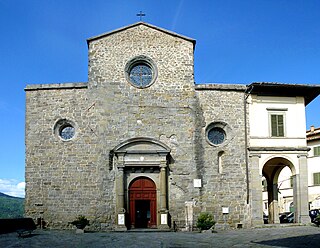
Cortona Cathedral is a Roman Catholic cathedral in Cortona, Tuscany, central Italy, dedicated to the Assumption of the Virgin Mary. It was the seat of the Bishops of Cortona from 1507 to 1986, and is now a co-cathedral in the present Diocese of Arezzo-Cortona-Sansepolcro.

Santa Maria della Pieve is a church in Arezzo, Tuscany, central Italy.

San Pietro alle Scale, also known as San Pietro in Castelvecchio is a Roman Catholic parish church located on via San Pietro, Terzo of Città, in Siena, region of Tuscany, Italy. Initially built in the 12th century, this parish church was completely rebuilt in a Baroque style in the 17th century; the brick facade has a portal with a depiction of Glory of St Peter. The belltower dates to 1699, and the facade to 1706.
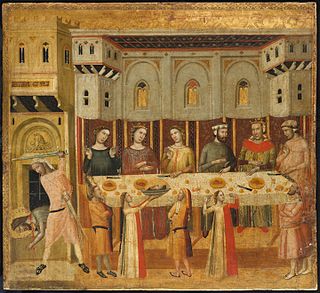
Giovanni Baronzio, also known as Giovanni da Rimini,, was an Italian painter who was active in Romagna and the Marche region during the second quarter of the 14th century. His year of birth is unknown. Giovanni Baronzio was the eminent representative of the second generation of painters of the school of Rimini who were influenced in by the activity of Giotto in Rimini.

Niccolò di Segna was an Italian painter from Siena. His activity is documented starting from 1331.

Master of Città di Castello, in Italian, Maestro di Città di Castello, was an anonymous painter of Medieval art. Mason Perkins is responsible for his identification and naming in 1908, based on the styling from the Master preserved at the Pinacoteca comunale, Città di Castello, in Umbria.
